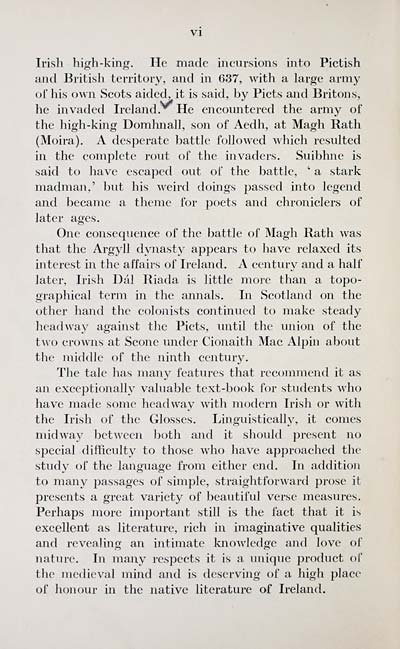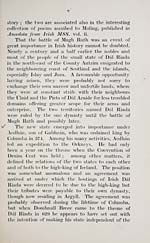Download files
Complete book:
Individual page:
Thumbnail gallery: Grid view | List view

Irish high-king. He made incursions into Pictish
and Britisli territory, and in 637, with a large army
of his own Scots aided, it is said, by Picts and Britons,
he invaded Ireland. He encomitered the army of
the high-king Domlmall, son of Aedh, at Magh Rath
(Moira). A desperate battle followed which resulted
in the complete rout of the invaders. Suibhne is
said to have escaped out of the battle, ' a stark
madman.' but his weird doings passed into legend
and became a theme for poets and chroniclers of
later ages.
One consequence of the battle of Magh Rath was
that the Argyll dynasty appears to have relaxed its
interest in the affairs of Ireland. A century and a half
later, Irish Dal Riada is little more than a topo-
graphical term in the annals. In Scotland on the
other hand the colonists continued to make steady
headway against the Picts, until the union of the
two crowns at Scone under Cionaith Mac Alpin about
the middle of the ninth century.
The tale has many features that recommend it as
an exceptionally valuable text -book for students who
have made some headway with modern Irish or with
the Irish of the Glosses. Linguistically, it conies
midway between both and it should present no
special difficulty to those who have approached the
study of the language from either end. In addition
to many passages of simple, straightforward prose it
presents a great variety of beautiful verse measures.
Perhaps more important still is the fact that it is
excellent as literature, rich in imaginative qualities
and revealing an intimate knowledge and love of
natvu-e. In many respects it is a unique product of
the medieval mind and is deserving of a high place
of honour in the native literature of Ireland.
and Britisli territory, and in 637, with a large army
of his own Scots aided, it is said, by Picts and Britons,
he invaded Ireland. He encomitered the army of
the high-king Domlmall, son of Aedh, at Magh Rath
(Moira). A desperate battle followed which resulted
in the complete rout of the invaders. Suibhne is
said to have escaped out of the battle, ' a stark
madman.' but his weird doings passed into legend
and became a theme for poets and chroniclers of
later ages.
One consequence of the battle of Magh Rath was
that the Argyll dynasty appears to have relaxed its
interest in the affairs of Ireland. A century and a half
later, Irish Dal Riada is little more than a topo-
graphical term in the annals. In Scotland on the
other hand the colonists continued to make steady
headway against the Picts, until the union of the
two crowns at Scone under Cionaith Mac Alpin about
the middle of the ninth century.
The tale has many features that recommend it as
an exceptionally valuable text -book for students who
have made some headway with modern Irish or with
the Irish of the Glosses. Linguistically, it conies
midway between both and it should present no
special difficulty to those who have approached the
study of the language from either end. In addition
to many passages of simple, straightforward prose it
presents a great variety of beautiful verse measures.
Perhaps more important still is the fact that it is
excellent as literature, rich in imaginative qualities
and revealing an intimate knowledge and love of
natvu-e. In many respects it is a unique product of
the medieval mind and is deserving of a high place
of honour in the native literature of Ireland.
Set display mode to: Large image | Transcription
Images and transcriptions on this page, including medium image downloads, may be used under the Creative Commons Attribution 4.0 International Licence unless otherwise stated. ![]()
| Early Gaelic Book Collections > Matheson Collection > Buile Shuibhne > (14) |
|---|
| Permanent URL | https://digital.nls.uk/76546130 |
|---|
| Description | Irish text, English preliminaries and notes. |
|---|---|
| Shelfmark | Mat.33 |
| Additional NLS resources: | |
| Attribution and copyright: |
|
| Description | Items from a collection of 170 volumes relating to Gaelic matters. Mainly philological works in the Celtic and some non-Celtic languages. Some books extensively annotated by Angus Matheson, the first Professor of Celtic at Glasgow University. |
|---|
| Description | Selected items from five 'Special and Named Printed Collections'. Includes books in Gaelic and other Celtic languages, works about the Gaels, their languages, literature, culture and history. |
|---|

